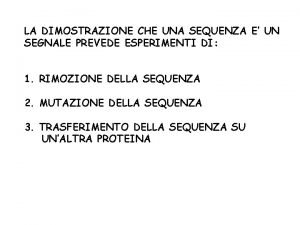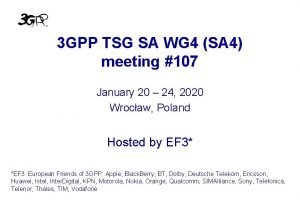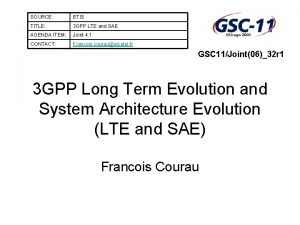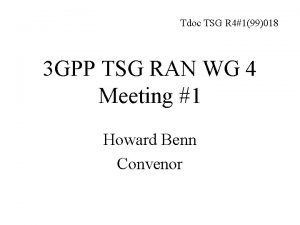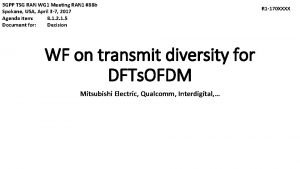3 GPP TSG RAN WG 4 AH1807 Montreal




- Slides: 4

3 GPP TSG RAN WG 4 AH-1807 Montreal, Canada, 2 -6 July, 2018 R 4 -1809559 WF on test cases for NR BS ZTE, [. . . ]

Background (1) • In RAN 4#87, it was agreed that RF channels B (bottom), M (middle) and T (top) should be considered case by case for NR in the WF[1] • In RAN 4#AH-1807, several contributions discussed the NR test cases: p R 4 -1809153 On test cases for NR BS conformance tests, Nokia, Nokia Shanghai Bell p R 4 -1808814 RF channel for NR BS RF conformance test, ZTE Corporation p R 4 -1808815 TP for TR 38. 141 -1: RF channel (section 4. 9. 1), ZTE Corporation [1] R 4 -1808318, WF on Test cases for NR BS conformance test, Huawei, Ericsson, Nokia, ZTE

Way forward on NR test cases (1) • All agreements in this WF apply to BS type 1 -C and 1 -H conducted requirements only • Down-selection of channel bandwidth case by case for single carrier cases – Option 1: lowest and highest bandwidth supported and declared by BS vendor for both FR 1 and FR 2. – Option 2: Other methods should not be precluded. • Down-selection of SCS for single carrier cases – Option 1: Only the supported narrowest SCS should be selected – Option 2: The supported narrowest SCS should be selected. For OBUE requirement, the highest supported SCS shall be considered when testing with widest supported CBW. – Option 3: Narrowest CBW with supported narrowest SCS and widest CBW with supported highest SCS

Way forward on NR test cases (2) • Down-selection of RF channels B/BRFBW(bottom), M/MRFBW (middle) and T /TRFBW (Top) : – For transmitter spurious emission • • FR 1 and FR 2 – Option 1: B and T for single carrier; BRFBW, TRFBW for multi-carrier and/or CA » B for spurious frequencies below the band, T for frequencies above the band – Option 2: B, M, and T for single carrier; BRFBW, MRFBW, TRFBW, multi-carrier and/or CA FR 2 B and T for single carrier; BRFBW, TRFBW for multi-carrier and/or CA – For transmitter intermodulation , in-band general blocking and receiver intermodulation for both FR 1 and FR 2 • • If the outermost edge of interfering signal is within operating bands, M for single carrier for both FR 1 and FR 2; MRFBW for multi-carrier and/or CA for both FR 1 and FR 2 Otherwise, B and T for single carrier; BRFBW, TRFBW for multi-carrier and/or CA – For narrow band blocking (only for FR 1 and FR 2? ) • • Option 1: M for single carrier; MRFBW for multi-carrier and/or CA Option 2: B, M, and T for single carrier; BRFBW, MRFBW, TRFBW, multi-carrier and/or CA – For other requirements • • Reuse the RF channel approach for the same requirements in E-UTRA for NR BS FR 1 and FR 2 • Option 1: B and T for single carrier, BRFBW, TRFBW for multi-carrier and/or CA • Option 2: Reuse the RF channel approach for the same requirements in EUTRA For muti-band operation, the RF channel approach defined in E-UTRA shall be reused for the same requirements for NR BS FR 1 and FR 2
